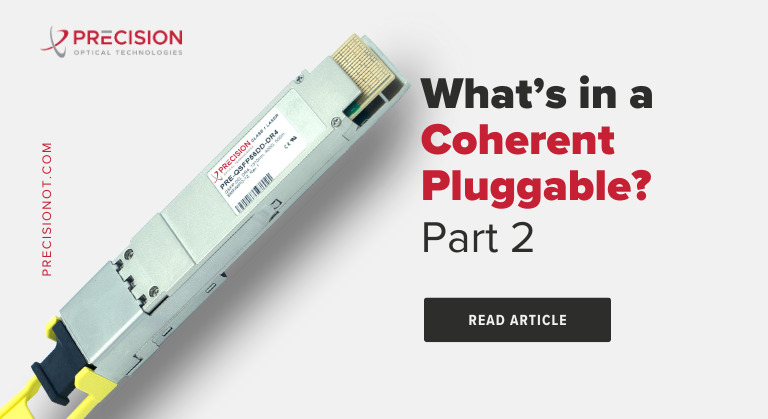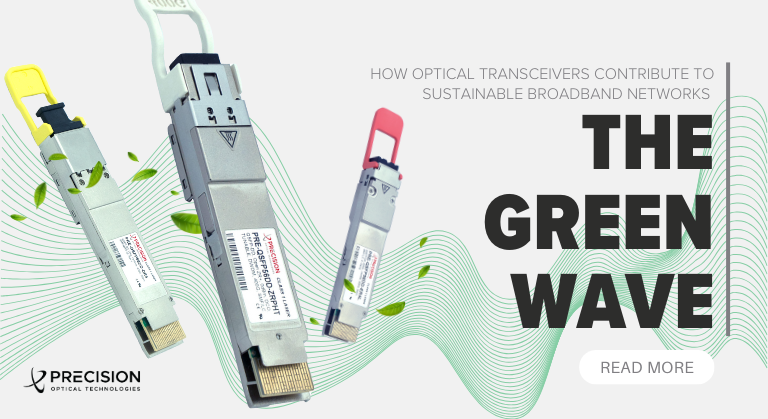
Harnessing Optical Transceiver Innovations for Eco-Friendly Networks

As Earth Day approaches and everyone’s thoughts turn to the subject of environmental sustainability and climate change, the optical networking sector finds itself standing at a unique point in time.
On one hand, fiber optic cables have always been the more sustainable choice over traditional copper wiring, especially from an energy consumption standpoint. For example, copper wiring consumes 3.5 W per 100 meters, compared to just 1 W with fiber optic cables. However, as hyperscale, enterprise and consumer demand for 5G, the IoT, artificial intelligence (AI) and machine learning (ML) applications heats up, so too do the pressures placed on network operators to keep up. That means everything from deploying new fiber to leveraging the latest high-performance optical transceivers (i.e., 400ZR, OpenZR+, 800G optics) to meet surging data volumes – all while ensuring the sustainability of their operations.
Rising energy costs are also spurring network operators to seek greater efficiencies, and with them, greater sustainability. McKinsey and Company note that in the last few years, large network operators have seen “energy cost increases outpace sales growth by more than 50 percent.” Although many network operators like AT&T and Telefonica, as well as hyperscalers like Google and Amazon, have pledged to reach net-zero carbon emissions, there is no easy pathway to achieve this. Rather, a deep dive into each aspect of one’s networks will be necessary – persistence is key.
One of the best places to start this journey is with optical transceivers, the technological synapses our world’s networks rely on to transmit data across vast distances reliably. Read on to find out the various ways optical transceiver innovations can help network operators in their quests for greater sustainability.
Efficiency and Sustainability Through Miniaturization
One of the most significant developments in optical transceiver technology is the continual trend towards miniaturization. Smaller form factors can mean reduced material usage in manufacturing, more efficient use of physical space, potentially less specialized equipment needed in a network and the possibility of decreased energy consumption during operation.
In a previous blog post, we created an infographic highlighting the evolution of optical transceivers. All the way back in 2003, for instance, MSA standards for 10G were established and XENPAK transceivers were born. Soon after, the first 10G SFP+ modules were developed. The SFP+ form factor offered a smaller alternative, enabling greater port density and lower power consumption – a boost for environmental sustainability. Since then, transceivers have continued to evolve with the goal of combining ever-higher performance capabilities into form factors that enable as small a footprint as possible.
As a case in point, the OIF 400ZR Implementation Agreement, which enabled the use of the QSFP-DD and OSFP form factors, revolutionized IP over DWDM (IPoDWDM) capabilities by eliminating the previous footprint penalty of DWDM optics that were around two times larger in size than client optics. The primary appeal of IPoDWDM is that inserting DWDM optics directly into the router eliminates the transponder shelf and optics between routers and DWDM systems—including the intermediate transponders as well as the gray optics that connect the shelves and routers. As we noted in a whitepaper on coherent optics, the elimination of transponder shelf hardware saves space and power. That can translate into operational savings of as much as 57% with routed optical network architecture.
As with everything in the world of optical transceivers, there are trade offs. The lower power of the 400ZR optics limits their maximum reach to 120km with amplification, which is acceptable for targeted metro DCI and point-to-point access network applications. Open ZR+ modules, on the other hand, enable a 500 km+ reach but consume more power. As you can tell, the decision to select an optic is governed by many factors. A vendor partner with deep-seated expertise in systems integration can help you understand how your transceiver performance requirements mesh with your sustainability goals – ultimately helping you select the right optics for your network.
Longer Reach, Fewer Resources
If miniaturization is one piece of the equation in enhancing sustainability, addressing transmission distance is the other. Optical component technology can extend the reach of optical transceivers, enabling data transmission over longer distances. How that is accomplished, however, is incredibly important from a sustainability perspective. Let’s look at an access network example to see how.
Modern access network operators are under extreme pressure to maximize the capabilities of existing infrastructure as they adopt new technologies like ESD DOCSIS, DOCSIS 4.0, R-OLT PON uplinks and other 5G solutions. While doing more with what one has is always a good strategy from a sustainability perspective, it is tough to get around the mathematical constraints of link budgets. At 10G in the access network, chromatic dispersion limits network links to approximately 80km. But as more access network operators begin eyeing 25G data rates, chromatic dispersion limits link distance to 10-15 km unless specialized equipment is used. From a sustainability perspective, this drawback is significant – using specialized equipment translates into a larger environmental footprint.
That’s where Precision OT’s proprietary Genesee™ Dispersion Compensation ASIC-enabled technology comes in. Using this ASIC, we’ve enabled a 25G tunable, DWDM module that enables users to reach transmission distances of 40km and beyond without the need for specialized equipment. It’s highly configurable, modulation agnostic, interoperable and expandable to other data rates. It’s the kind of solution that also addresses the idea of future-proofing a network, which, given the need to reduce our sector’s effect on the environment, is an optimal strategy.
End-to-End Sustainability
It’s not just the optical transceivers themselves that have a role to play in improving the sustainability initiatives of modern network operators. It’s also about how the transceivers are sourced and what kinds of sustainable practices vendor partners adopt. Much like modern data center tenants look to their providers to enhance sustainability throughout every aspect of their operations, a good optical equipment vendor should be doing the same for their customers.
That’s our commitment to you – sustainability is something we apply both to our own internal operations as well as in relation to our supply chain. From vetting all our suppliers according to a strict set of criteria that includes various ESG metrics to keeping our already-small carbon footprint as low as possible (using everything from low energy LED light bulbs to low-flow toilets and energy efficient appliances), sustainability is always top-of-mind for us. In fact, our global presence helps us lower our carbon footprint by reducing our need to ship equipment internationally. As well, we strive to source components that use less power. In addition to helping our customers save on power usage, it also assists them in their sustainability efforts. Read more about our ongoing efforts here.
Creating a Sustainable, Digital Future
Optical transceivers can play a vital role in advancing the environmental sustainability of network operations. Through miniaturization efforts (including the shift towards very small form factor transceivers, a topic for another time), efficiency improvements and power optimization, these critical components can contribute to reducing carbon emissions, conserving resources and minimizing environmental impact across the telecommunications industry. That said, it’s a complex environment to navigate and network operators must take many factors into account when choosing the appropriate transceiver. Link distances must be weighed against an optic’s performance capabilities. Concerns over interoperability must be addressed. There really is no one-size-fits-all solution.
As we celebrate Earth Day, it’s important to remember that sustainability is an ongoing journey. Persistence and patience pay off. Most importantly, having the support of a sustainable vendor partner is indispensable in creating solutions that can turn your goals into reality while also enhancing your sustainability initiatives and helping us create a greener, more sustainable future.






